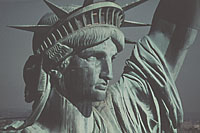
Soundtracks:
Manhattan
Rhapsody in Blue




|
Rhapsody in Blue
About the piece
"Rhapsody in Blue" is one of the examples for a piece which
is not uniform in structure, but full of inspiration and magic, and for
this it holds a place of honor in the 20th century pantheon. "Rhapsody
in Blue" is, in fact, more a series of melodies than one piece. But
those melodies are so excellent, so vivid and with such fascinating, powerful,
energetic rhythms, that the piece transmits a permanent sensation of rejuvenation
and freshness. Gershwin actually got his fame thanks to that piece, as
a serious, important composer. After this success, he dared to write some
more works, like the Piano Concerto in F major, "An American in Paris",
and the opera "Porgy and Bess", that made black artists equal
partners in the cultural life of art music in America.
Background
Paul Witmann, a successful American conductor, turned to Gershwin in
January 1924 and asked him to write him a symphonic work. Witmann, an experienced,
talented musician, most of whose success was in the field of light music
until then, had an ambition to enter the established, prestigious concert
hall. Gershwin started composing the rhapsody without any definite outline
or structure. He was deeply motivated by his will to contradict the common
opinion of the time, that jazz is a limited style, bound to fast tempos
and dancing rhythms, and he decided this work would be his winning argument
against this claim. He began processing several themes and melodies for
the rhapsody. On his way to a concert in Boston, listening to the noise
the train made and the tracks' hammering, he decided on the piece's character:
a musical kaleidoscope of America, with the famous "melting pot",
the American sentimentality and the love of the city. The first theme came
to his mind during a party, in which he played to his friends' amusement.
He found himself playing an improvised tune, and immediately knew this
was the main theme of his work.
The week after he returned from Boston, he completed the rhapsody's
outline. Witmann embraced the piece, and asked an accomplished musician
to orchestrate the work for a symphonic ensemble. Gershwin himself said
later that he learned from that orchestration of his work how to arrange
for an orchestra by himself, and indeed he did his own orchestrations after
that.
|